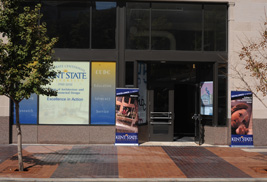Featured Article
Cleveland Urban Design Collaborative Celebrates Its New PlayhouseSquare Location
A unique city-university partnership, the Cleveland Urban Design Collaborative is a community service organization committed to improving the quality of urban spaces by providing design services, research and advocacy for cities, neighborhoods and institutions in the region.
read moreCleveland Urban Design Collaborative Celebrates Its New PlayhouseSquare Location
Posted Sept. 27, 2010Kent State University's Cleveland Urban Design Collaborative makes its debut in its new location in Cleveland's PlayhouseSquare District. A unique city-university partnership, the Cleveland Urban Design Collaborative is a community service organization committed to improving the quality of urban spaces by providing design services, research and advocacy for cities, neighborhoods and institutions in the region. The collaborative's new address is 1309 Euclid Ave., Suite 200, in Cleveland, placing the it within PlayhouseSquare and directly on Cleveland's refurbished Euclid Corridor.

The new home of the Cleveland Urban Design Collaborative
To showcase the new location, the university held its first Board of Trustees meeting for the 2010-2011 academic year at the Cleveland Urban Design Collaborative on Sept. 15. That evening, Kent State University President Lester A. Lefton and the university's trustees also hosted a grand opening reception. Those who attended the private reception included graduates of Kent State's College of Architecture and Environmental Design, Cleveland-area Kent State alumni, and regional business and community leaders.
"The work done by Kent State's Cleveland Urban Design Collaborative and its continued presence in downtown Cleveland demonstrate our commitment to help rebuild and revitalize Cleveland and Northeast Ohio," Lefton says. "Kent State's Cleveland Urban Design Collaborative first opened in Cleveland in 1999, providing research and technical expertise to the city's leaders and policy makers for more than a decade."
Douglas L. Steidl, FAIA, the new dean of the College of Architecture and Environmental Design, of which the collaborative is a part, said the collaborative offers a wonderful experience for the college's architecture students. "Our graduate students have the opportunity to work in an urban setting and work on real-world projects," Steidl says. "By studying at this facility, they are engaged in real-world design challenges and investigate new planning and development opportunities in collaboration with our very creative staff."
Key projects that the Cleveland Urban Design Collaborative has worked on include conceptual designs for Public Square in downtown Cleveland; the Cleveland Rowing Foundation's proposed riverfront facility; "Re-Imagining a More Sustainable Cleveland" plan in collaboration with Neighborhood Progress Inc., the Cleveland City Planning Commission and ParkWorks that focuses on vacant land strategies; "Pop Up City," a temporary-use project, which activates some of Cleveland's most spectacular but underutilized vacant places as havens for cultural and arts activities, and research for supportive housing for the mentally ill.
A driving force behind the Cleveland Urban Design Collaborative is Terry Schwarz, an urban planner who was named director of the collaborative this summer after serving as its interim director. Schwarz's expertise includes neighborhood and campus planning, commercial and residential design guidelines, and green infrastructure design strategies. She is well-known among the local, national and international planning communities.
Schwarz points out that the new location of the collaborative is very attractive. "Our new location is in the District of Design, which is the area in downtown Cleveland surrounding PlayhouseSquare, from East 13th to East 18th streets, envisioned to include architecture, engineering, design and planning firms and programs," Schwarz explains. "We are a part of the steady, but accelerating, progress of the District of Design by becoming one of its new, key tenants."
The move of the collaborative from its previous location in the Gateway District to the PlayhouseSquare District was supported by grants from the Cleveland Foundation, the George Gund Foundation, the Kent H. Smith Charitable Trust, and the Kelvin and Eleanor Smith Foundation. The facility also benefited from historic preservation tax credits.
Kent State has the region's only college of architecture. Its architecture graduates ranked in the top 20 out of approximately 150 accredited programs in the 2009 national Architect Registration Examination. Kent State's Cleveland Urban Design Collaborative currently has 24 graduate students and six faculty and staff members, plus visiting faculty.
For more information about Kent State's Cleveland Urban Design Collaborative, call 216-357-3434 or visit www.cudc.kent.edu.